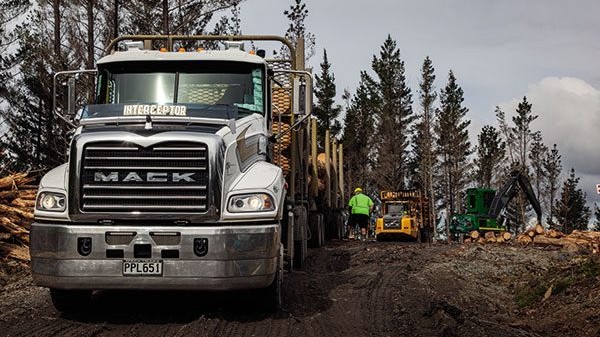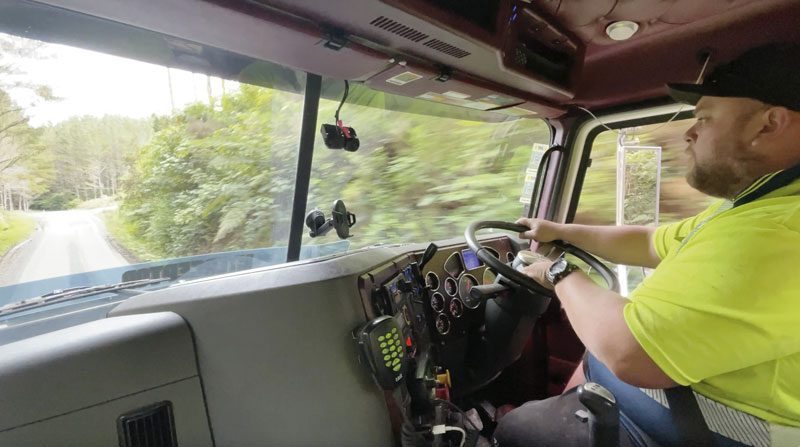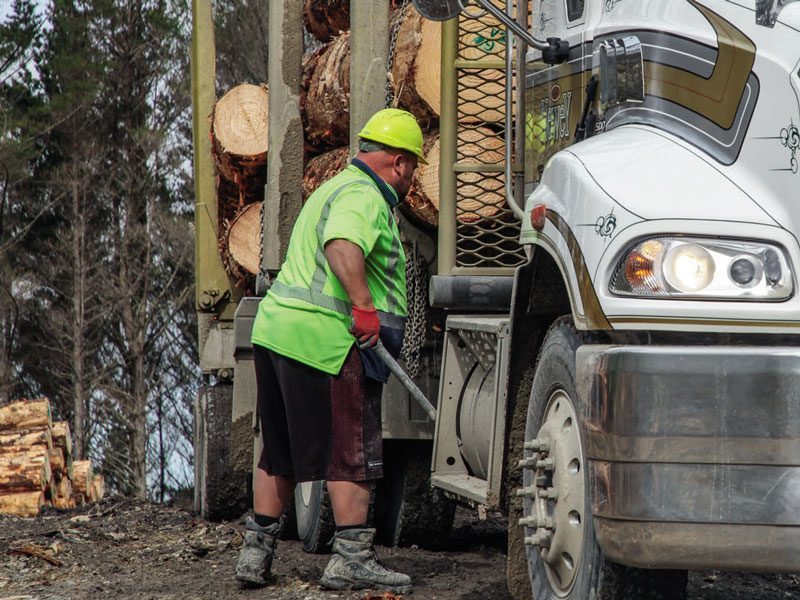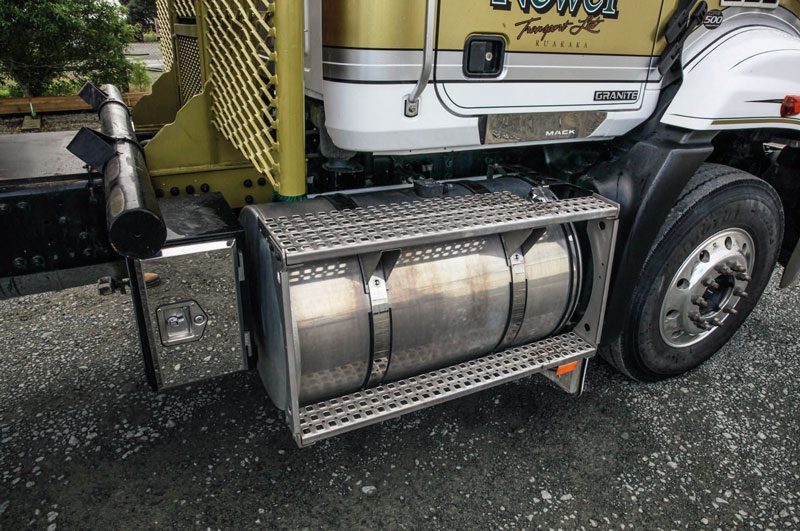Featherweight tactics Part 2

It’s a quote that sums up Ian Newey’s thinking in a nutshell: “If you’re not carting 32 tonne on nine-axles at 50MAX, there’s no point… You should be then running seven axles. That’s in our view… You can cart close to 30 tonne with seven axles for a lot less capex.”
The more we discuss operating log trucks with Ian, the more apparent it is that doing so in Northland presents challenges most operators in other areas of the country can be relieved they don’t have to worry about. Moving as many logs as possible means having the most payload capacity as possible on trucks that must traverse highly restrictive roads. The lighter the truck, the more it can carry within the limits. For many, 50MAX isn’t even an option.
“Only two are rated at 54 tonne out of our whole fleet. We can run 54 tonne out of Riverhead, Hunua and Clevedon, but we can’t even run 50 in some parts of the Far North,” says Ian.

“It’s not going to change in Northland anytime soon,” he continues. “It’s all well and good throwing money at the state highways, but there aren’t many forests that lead directly off the state highways. The further north you go, the less attention the 44-tonne bridges are going to get. And if you’ve got a 44-tonne bridge between you and the forest, you need to be able to cross it…”
The problem extends to some of the forest roads, too. “The Dome, for example – it’s coming into its second cycle now. We used to pull out of there at 44 tonne with four-axle truck three-axle trailer combinations. They want to reuse the existing tracks from the last cycle, but in 25 years, the road transport fleet has changed. We won’t pull 54 tonne out of there because we’re just never going to get up. But if they get the compaction right, the seven-axle combination will, and with a decent payload,” says Ian.
It all sounds simple, but Ian’s a savvy operator who knows what he’s dealing with and does his homework.
“We built a cost model with the four different configurations – four-axle truck three-axle trailer, which is no longer fit for purpose, three-axle truck four-axle trailer, four-axle truck four-axle trailer, and four-axle truck five-axle trailer. We put them on a parity doing the same runs every day and added into that capex, fuel, tyres, all these assumptions.
“The nine-axle combination spat out the best result for return on investment, as you’d expect. But closely behind was the three-axle truck four-axle trailer combination. So, it became obvious to us which way we needed to go – our future in Northland is nine or seven axles.”


There’s nothing on it…
The bare combination needs to be astonishingly light to carry a close-to 30-tonne payload of logs with a modern vehicle restricted by what amounts to a 44-tonne GCM. However, in building the Granite, Ian had a template that came, interestingly, from the opposite end of the country.
“In 2017, we acquired two of Bill Richardson’s six-wheeler CHs with four-axle Southern Engineering trailers. They had both done only about 700,000km – the operators don’t do big Ks in the South Island. And they had sensational combined tare weights – 14,800kg. So, predominantly in the Far North, with 44-tonne restricted bridges, these things were still coming out there with 29.5 tonnes on, where everything else was carrying 26 tonnes.”
Those trucks were on-sold to a couple of guys looking for a stepping stone into the industry with low capex. Ian financed them into the trucks as ODs for Neweys, so while the trucks were still within the fleet, he knew what the concept could deliver and wanted more.
“Over the Covid period, I said to Carl [Capstick], ‘I want that again, but new. How can we do it?’ We targeted a 15-tonne tare weight… We had to be realistic. We knew it would have AdBlue and other equipment the CH never did,” Ian explains.
To have any chance of achieving this ambitious target, the base had to be a Granite. For the rest, Ian, Carl and the technical boffins at Motor Truck Distributors put their heads together. “We won’t go into too much detail about how we did it, but we got there in the end,” Ian says contentedly.
In essence, anything that didn’t need to be on the truck was binned, and anything that did have to be there was pared down to its most compact form possible. The second fuel tank, gone, leaving a single 350L tank at the right-hand side. Other than a small locker alongside, that’s all the driver will see approaching the cab. The passenger has to contend with the 8×4 Trident’s left-hand-side combined entry-step/ SCR exhaust cassette with underframe exhaust. Watch your step, that round one at the bottom’s not for cab entry… Behind this sits the 125L AdBlue tank. And because the tanks are all forward of the headboards, no tank guards are needed – more weight saved. This also goes for the batteries and air tanks, which were mounted inboard of the chassis under a simple board of MDF.
“The whole mindset was tare weight, without compromising the truck’s integrity,” Ian explains.
“We thought, if the Trident can have that exhaust/step assembly, why can’t the Granite? It’s not like we could have ‘chimneys’ anyway. To get the trailer behind it, the headboard had to be right up there.”
That trailer was an existing 2011 Highway Hound step-deck unit with a 5.8m wheelbase. Ian explains the reason for needing a 5.8m wheelbase trailer was to avoid cubing out. “You typically cube out on the trailer with a four-axle single-bay configuration – you can’t get enough wood on it. So, to make it work, we needed a long-wheelbase trailer so we could double pack it with 5.9s. And it keeps the load height down.
“A local engineer, Warwick Dawson, Dawson’s Design, did the drawings for us, and the trailer would fit – only just.”
The bolsters were also existing units – a Patchell set from an old refurbished truck. The Newey team rigged the unit in the company’s workshop, leaving all the certification and welding to local outfit Ten-4 Engineering.
“We just bolted it all together like a Meccano set. The beauty of us doing that was we could see what we didn’t need and what could be removed as we were going. We’d go to the local weighbridge and keep checking what it weighed.” And the result? A tare weight of 15,140 tonnes – 9700kg on the truck and 5440kg on the trailer.
Moo-ving through Glenbervie
Not only is Newey Transport’s latest Granite special for the unique concept it explored and delivered, but it’s also special for being the last of its kind. We’re normally reluctant to talk about firsts and lasts, but in this case, we have it on good authority that Newey Transport fleet No.36 was the last Granite build for New Zealand and the last to enter service in the country. It’s also the last with an 18-speed manual transmission, and the last Mack for our market with the classic burgundy pleated ultra-leather.
Both features were something of a ‘happy accident’… The truck wasn’t expected with the Western Trim treatment, and as for the Roadranger shifter poking up from the floorboard, Ian says: “We already had mDrive autos in the fleet and loved them. But I was having a day when I wanted a manual. About a month later, I changed my mind and rang Carl, but it was too late to change it to an auto.” Not that it bothers Ian – as we’ve covered, he doesn’t believe the want to conduct cogs is dead and buried among drivers.
The following morning, we meet No.36’s driver, Billy Kanara, bright and early at the Weigh Northland station. New to log truck driving but described by Ian as “a duck to water”, Billy’s one of those newcomers who wants to master the art of driving the old-school way. “I’m still getting my head around the Roadranger,” he openly admits as we head off. No judgement here, mate!
Our destination is the Rayonier Matariki Forest in Glenbervie, just north of Whangarei, No.36’s usual haunt. The skid is deep in the forest, but the access roads are by all accounts top class. And as we’d soon learn, the logging crew led by Northlander Jacko Rata is among the most efficient, efficacious and accommodating we’ve recently encountered.
The run up from Ruakaka is short, roughly 40km. Indeed, No.36 had clocked up a reasonable 40,500km in the five months it had been traversing Northland by the time we’d met Billy. We join SH1 at the roundabout with Port Marsden Highway and head north. It’s virtually flat running, a simple cruise with some stop-start through the city before turning off SH1 into the access road. There’s nothing to it, really. Billy’s relaxed driving style barely summons the available 373kW (500hp), with the MP8 emitting a smoother, more refined note from that single low-exit exhaust than one would be accustomed to with a pair of stacks behind the cab.


“I think it needs a touch more power sometimes,” comments Billy. “For example, climbing the Brynderwyns with near 30-odd tonne on can be… slow.”
There are two access roads to the Glenbervie Forest, mainly used as one way in, one way out to smooth the flow of trucks on busy days. According to Billy, it’s not uncommon for trucks to queue. Luckily, it was quiet on both of our trips in.
“She’s quite a big site. You don’t realise it until you get over the hill and out the back there,” says Billy. “Oh, yell out if you happen to see a cow…” he adds with a laugh.
A cow? Apparently, a farmer neighbouring one of the access roads had the misfortune of his herd escaping their paddock…
“There’s still about a dozen of them in here that haven’t been found!”
The drive to the skid is a full 20 minutes of dips, rises and switchbacks – no cows – but the Granite isn’t the least fazed heading in and later gets out just fine with trailer and 29-tonne in tow. Bigfoot CTI is fitted for the extra-demanding sites and has been called into action on occasion. Despite the on-and-off rain, there’s no need for it on our excursion. As Ian had commented: “You can’t beat the traction of a six-wheeler, they’ll climb up the side of a cliff. There are some of those forests around…”
Of course, the easy going is also down to the driver. For someone so new to the world of logs, Billy’s a smooth operator, always looking ahead, gentle on the gear, and conscientious to, at and from the skid. The MP8 certainly deploys every bit of its 2495Nm (1840lb/ft) on some of the more demanding climbs, as Billy smoothly drops it down a few cogs and lets it pull itself up and out at its own pace.
“I’d rather a manual than an auto out here,” he adds. “When you select a gear, it stays in. Some autos can wander between gears.”
Having come off Newey’s older four-axle Granite, Billy reckons the three-axle unit offers a bit more comfort and while the 8×4’s extra set of paws helps with maintaining course in the mud, the 6×4’s tighter steering lock comes into its own on the tighter sites he tends to visit.
Average fuel economy thus far is a fair 1.9km/L.
To the future
Just as the Neweys’ approach to business melds modern leanings with traditional values, Ian’s approach to spec’ing No.36 melds the conditions of modern-day trucking with back-to-basics thinking.
It might appear to be ‘just’ another Mack Granite at face value, but that would be selling the concept short. It’s a truck created from a desire to do the job as efficiently as possible, to offer the best return possible, in conditions that force that kind of thinking. As the saying goes, ‘Out of adversity comes opportunity…’
And the best bit? As the curtain closes on the Granite, the Neweys’ three-generation allegiance to the Mack brand, and desire to push the limits of tare weight to get the most out of their investment in tough conditions, are both secure… There’s a new Anthem on the way – a different configuration with a five-axle, 6.1m wheelbase, triple-bay trailer, no less. And they should, by all estimations, be able to follow No.36’s recipe with the Anthem platform, too.
Just call it the ‘Northland combination’.
Special thanks
Our thanks to Ian and Shelley Newey for sharing their story, opening up their operation and allowing us to showcase their unique approach to transport, both in the office and on the road.
To Billy Kanara, thanks for having us along and tolerating our journalistic and photographic antics. And to Rayonier Matariki and Jacko Rata, for doing the same and accommodating us on your skid.
Finally, the legendary Carl Capstick… thanks for your unfailing support of our business.

Read more
Of culture and longevity
0 Comments37 Minutes
Life’s essentials
0 Comments43 Minutes
Hiding in plain sight
0 Comments34 Minutes
Proceeding Reputations
0 Comments25 Minutes













